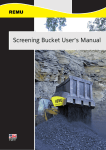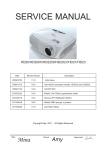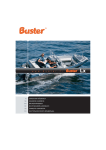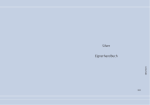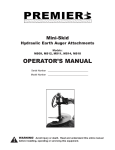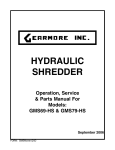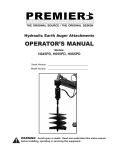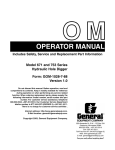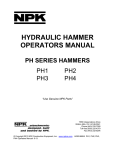Download Screening Bucket User's Manual
Transcript
Screening Bucket User’s Manual English USER MANUAL EC Declaration of conformity for machinery (Machinery Directive 2006/42/EC, Annex II., sub. A) Manufacturer: Address: REMU Oy Inhantie 7, 63700 Ähtäri, Finland Name and address of the person authorized to compile the technical file: Name: Address: Juha Salmi Inhantie 7, 63700 Ähtäri, Finland Herewith we declare that REMU Screening Bucket Model: …………………………. Serial number: ……………… is in conformity with the relevant provisions of the Machinery Directive (2006/42/EC) And furthermore, we declare that - the following (parts/clauses of) European harmonised standards have been used: SFS-EN ISO 12100, SFS-EN 349 Ähtäri ___/___ 20___ Juha Salmi Managing Director USER MANUAL Table of contents 1 2 3 SAFETY PRECAUTIONS FOR OPERATION ........................................................ 7 1.1 Safety Labels ........................................................................................... 7 1.2 Safety Procedures Before Operation ...................................................... 8 1.3 Safety Procedures During Operation ...................................................... 8 1.4 Safety Procedures After Operation ........................................................ 9 INSTALLATION OF THE SCREENING UNIT ..................................................... 10 2.1 Base Installation Requirements ............................................................ 10 2.2 Hydraulic Horsepower Requirements................................................... 10 2.3 Testing of Hydraulic Requirements....................................................... 11 2.4 Flow Rates of Excavators ...................................................................... 11 2.5 Over Speed............................................................................................ 12 2.6 Controlling the Bucket .......................................................................... 12 2.7 Hydraulic Pressure Settings .................................................................. 12 2.8 Connection to Work Unit ...................................................................... 13 2.9 Installation to Work Unit ...................................................................... 13 2.10 Installation Check List ........................................................................... 13 OPERATION .................................................................................................. 14 3.1 Quick Guide for Operation.................................................................... 14 3.2 Safety .................................................................................................... 16 3.3 Operation Efficiency ............................................................................. 16 3.4 Filling the Bucket................................................................................... 16 3.5 Screening Process ................................................................................. 17 3.6 Moisture Content.................................................................................. 18 3.7 Cleaning the Bucket .............................................................................. 18 3.8 Cleaning Attachment ............................................................................ 19 3.9 Neglect .................................................................................................. 19 3.10 Converting the Bucket to the Crushing/Screening Configuration ........ 19 2 USER MANUAL 3.10.1 From Screening to Crushing Configuration................................... 19 3.10.2 From Crushing to Screening Configuration................................... 20 3.11 4 Modifying the Grain Size ....................................................................... 21 3.11.1 Changing the Counter Blades........................................................ 21 3.11.2 Changing the Cleaning Scrapers ................................................... 21 MAINTENANCE ............................................................................................. 23 4.1 Maintenance Schedule ......................................................................... 23 4.2 REMU Parts ........................................................................................... 23 4.3 Contaminated Products ........................................................................ 23 4.4 Maintenance Safety .............................................................................. 24 4.5 Maintenance Items and Intervals ......................................................... 24 4.6 Rotors Maintenance ............................................................................. 27 4.7 Hardfacing Procedure ........................................................................... 27 5 MAINTENANCE UNDER SPECIAL CONDITIONS ............................................. 28 6 TROUBLESHOOTING ..................................................................................... 29 6.1 Dealing with Fault Diagnosis ................................................................. 29 6.2 Possible Faults....................................................................................... 29 6.2.1 Hydraulic ....................................................................................... 29 6.2.2 Mechanical .................................................................................... 29 6.3 7 8 Fault Diagnosis ...................................................................................... 30 6.3.1 Rotors Cease to Turn .................................................................... 30 6.3.2 Rotors Turn Slowly ........................................................................ 30 6.3.3 Grain Size Increases ...................................................................... 31 STORAGE ...................................................................................................... 31 7.1 Storage Preparation .............................................................................. 31 7.2 Removing the Bucket from Storage ...................................................... 31 TRANSPORT AND LIFTING ............................................................................ 32 8.1 Transport when Mounted on the Work Unit........................................ 32 3 USER MANUAL 8.2 9 Shipped as Stand Alone Bucket ............................................................ 32 SPECIFICATIONS ........................................................................................... 33 9.1 Grain Size .............................................................................................. 34 4 USER MANUAL SAFETY NOTICE The warnings in this operator and maintenance manual are not all-inclusive. Though every effort has been taken to ensure a detailed coverage, REMU cannot anticipate every possible circumstance that might involve a potential hazard. If operation or maintenance is not performed as specifically recommended by this manual, you must ensure that it is safe for you and others. You must also ensure that the REMU screening bucket will not be damaged or made unsafe by the method you choose. APPLICATION WARNING REMU occasionally modifies some REMU screening buckets specifically at the request of the customer to meet the special application needs. It should be noted that these modifications totally change the performance and operation characteristics of the standard REMU unit and these characteristics must be fully understood by the user. Owners and operators are hereby advised that the use of modified REMU Screening Buckets in applications for which they were not intended is strictly prohibited. If the bucket is operated in conditions for which it was not designed, severe damage will occur to the drive mechanism. Damage caused by inappropriate applications will not be supported by REMU’s warranty. Owners and Operators are hereby obliged to check with the distributors or manufacturers to ensure the particular screening unit will meet the desired application. 5 USER MANUAL FOREWORD We wish to thank you for choosing the REMU screening bucket. Please take time to read this manual carefully as it must be read in conjunction with the operator’s manual of the work unit. This will help you to utilise the REMU screening bucket efficiently and economically. Your safety and the safety of others depend upon care and judgement in the operation of this attachment. A careful operator is good insurance against accident. REMU’s policy is to continually improve the product design that will provide changes to this REMU screening bucket, which may not be included in this manual. This publication is based on current information at the time of the printing. SERIAL NUMBER LOCATION Serial number is located on the top right hand side of the unit when viewed from the work unit’s operator seat adjacent to the motor. 6 USER MANUAL 1 SAFETY PRECAUTIONS FOR OPERATION Many failures and accidents that occur during operation or servicing are a result of neglecting fundamental precautions. Do not operate this unit unless you have read and understood the instructions in this manual. Do not allow anyone to operate this unit without reading this manual. Unauthorised modifications to this unit may impair the function and/or safety and reduce service life. 1.1 Label Safety Labels Explanation Maximum allowed hydraulic oil flow (See your bucket for correct value). Maximum allowed hydraulic oil pressure (See your bucket for correct value). Lubricate in every 8 hours. Lubricate in every 30 hours. 7 USER MANUAL Do not put your hands near or between moving rotors. Read the manual before operating the bucket. 1.2 Safety Procedures Before Operation It is strongly recommended that the limitations and performances of the REMU screening bucket and the work unit be fully understood before any attempt is made to operate the screening bucket in a production environment. Learn and apply the procedures and rules relative to the work site. Establish a means of communication in the event of accident or fire. Complete standard daily checks of the screening unit as well as the work unit. Clear obstacles from work area and be aware of hazards including overhead wires. Never use diesel or petrol as cleaning solvents. Inspect unit, rotors and hoses for damage and make the appropriate repairs before operating. If the bucket is fitted to the work unit via a quick hitch, ensure that the quick hitch is capable of withstanding thrust in the direction it is applied. Ensure that the work area is clear of personnel at least for a radius of 25 metres (80 feet). Mark the working area to avoid people entering it. 1.3 Safety Procedures During Operation Do not lift the work unit off the ground by transmitting the full weight of the machine on to the screening unit, as severe structural damage may occur to the bucket. 8 USER MANUAL Ensure that the work area is clear of personnel at least for a radius of 25 metres (80 feet). Do not allow unauthorised people in the work area. Test operation of the rotors with empty bucket. Operate the bucket only while seated in the work unit operator’s seat. Periodically check the bucket and tighten bolts that may have worked loose. Operate the bucket at a speed that can be correctly controlled. Do not use the bucket for demolition. Keep the bucket as low as possible when working to ensure safe and efficient use. Keep work site flat by continually grading to ensure efficiency and safety Do not overload the work unit. When loading trucks or hoppers, be careful not to hit the truck or hopper with the bucket. Do not swing the bucket over personnel or the cabs of the trucks. Do not work when dust, fog or smoke reduces visibility to an unsafe situation. Ensure that the job site is sufficiently alight for night work. Stop the machine frequently during night work and walk around and inspect the bucket and the work unit. 1.4 Safety Procedures After Operation Lower the bucket on to a flat solid ground that is free from falling material and flooding. Lubricate the bucket’s moving parts in accordance with the preventative maintenance schedule. Clean and inspect the screening bucket for any irregularities in structure and performance. 9 USER MANUAL 2 INSTALLATION OF THE SCREENING UNIT Investigate and ensure that the work unit is capable of handling the loaded weight of the screening bucket safely. The installer must ensure that the stability of the work unit is not impaired and the work unit’s lifting capacity is not exceeded (work unit lifting capacity charts can be found in the work unit manual). The hydraulic horse power capacity needs to be known to determine if it is able to provide sufficient capacity to operate the screening bucket at its optimum. 2.1 Base Installation Requirements The screening bucket requires bidirectional flow from the work unit. An operator controlled directional control valve and plumbing to the boom tip capable of handling the required flow and pressure needs to be installed on the work unit. It should be noticed that work units fitted with variable displacement hydraulic pumps need to have the hydraulic horsepower demand curves checked to determine that the work unit can deliver the required flow at the required pressure without exceeding the horsepower output of the work unit. A sufficient flow and pressure without unduly straining the work unit may necessitate the addition of more hydraulic fluid, the amount of which will vary depending on the type of the work unit. 2.2 Hydraulic Horsepower Requirements If the work unit cannot provide the required flow, pressure and/or the required hydraulic horsepower then the screening bucket’s maximum efficiency will not be achieved. The work unit flow, pressure and horsepower requirements can be obtained from the manufacturer or distributor of the work unit. If the carried hydraulic capacity is unknown then a flow test will have to be carried out by a suitably competent person. These flow and pressure tests will have to be recorded to ensure an accurate record is kept for warranty registration purposes. 10 USER MANUAL 2.3 Testing of Hydraulic Requirements It is in the interest of a trouble free commissioning process and long term service life that the hydraulic performance of the proposed work unit is measured, adjusted and recorded to ensure that the work unit is providing the required flow and pressure. Using a serviceable flow meter installed in the delivery lines that the screening unit will be fitted to is the only effective method to determine accurately the work unit’s hydraulic performance. Note! Some modern construction machines have flow and pressure sensors that provide readings on a liquid crystal display located in the cab. This feature only provides a theoretical indication and should not be relied upon. The flow and pressure must be physically checked to ensure accuracy. (See flow, pressure and horsepower details.) 2.4 Flow Rates of Excavators Note that modern excavators are capable of producing more flow than required for the screening bucket. The flow to the screening bucket circuit must be restricted to the maximum allowable flow (please refer the specification table and labels on the bucket). If the flow exceeds the recommendations, the unit will suffer over speed that will result in an early failure of the drive chains and motors. Larger excavators (10 tonnes and above) and some large wheel loaders are fitted with a variety of “load sensing” control systems that are known in the industry under various trade names. The function of these systems is to provide the required flow when demanded by the operator. Therefore the installer will have to determine the type and control methods of the load sensing system employed on the work unit and adjust or modify the system to ensure that the required flow rate of the screening bucket is not exceeded. 11 USER MANUAL In case the installer is unable to operate the load sensing control system, the control needs to be done in cooperation with the manufacturer or distributor. 2.5 Over Speed If a failure occurs due to over speed, then the warranty will not apply. Check the flow rate to the REMU circuit under the following conditions: The unit just below maximum relief valve setting. The unit under no load condition. With other functions of the work unit being operated at the same time. In all cases the flow rate must not exceed maximum recommended. 2.6 Controlling the Bucket REMU screening bucket has heavy rotors that are turning with screened material on top of them. The process of screening is based on turning rotors on both directions and changing the direction continually during screening. REMU recommends that the bucket must be installed to a control system where the rotating direction of the rotors can be proportionally changed instead of using quick turning by on-off switch. Quick turning may damage the chains of the bucket and cause excess wear to other parts of the bucket. If you do not have proportionally hydraulics in your work unit, make sure you do not turn the rotors from one direction to another quickly. 2.7 Hydraulic Pressure Settings The REMU bucket’s operating pressure should not exceed the recommendations. Inline relief valves should limit the circuit that operates the unit. It should be noted that some excavator manufacturers use flow cut-off systems when the circuit relief is activated. A thorough understanding of the work unit’s hydraulic design parameters must be understood prior to the design of the installation. 12 USER MANUAL 2.8 Connection to Work Unit In the case of excavators it should be noted that the manufacturer recommends that the REMU screening bucket be installed in a ‘face shovel’ application. The installation in a face shovel application will increase efficiency by reducing cycle times and reducing excessive strain that can be exerted on the unit. 2.9 Installation to Work Unit Use safety glasses and gloves for protection against injury when installing connecting pins. Ensure the quick hitch coupling specification of the work unit is to the same dimensions as the pick up on the screening bucket. If a quick hitch is installed it is the operator’s/owner’s responsibility to ensure the forces can be transmitted through the quick hitch. Information regarding this specification is available from the manufacturer upon request. Make sure the bidirectional auxiliary hydraulic flow is connected to the buckets hydraulics. Remember also the drain line. If at any time the installer is unsure of the requirements of the installation, the installer has the responsibility to contact the dealer or manufacturer to obtain the correct up to date information. 2.10 Installation Check List The following installation check list needs to be observed by the installer: Attach and secure the screening bucket after ensuring that the coupling method specifications match those of the work unit. Connect the hydraulic connecting hoses after ensuring the couplings from the work unit match the hoses for the screening bucket and are in a clean serviceable condition. Make sure you connect also the drain line. Check and record REMU circuit system flow and pressure at the appropriate place on the service report. In the case of excavator unit, ensure that the maximum flow rate will not be exceeded under the following conditions: o When unit is operating just below maximum relief valve setting. 13 USER MANUAL o o 3 When unit is under no load. When other functions of the work unit are being operated at the same time. In the case of skid steers, backhoes/loaders, wheel loaders, position the bucket so that the bottom of the unit is parallel with the ground, with a slight tilt to the front and mark or adjust the auto-levelling device to indicate the digging position. At low engine R.P.M., operate the screening unit in one direction for approximately twenty seconds to expel air from the hydraulic lines. Carry out preventive maintenance procedure as explained in this manual. Ensure that the bucket’s flow rates have been checked under a variety of conditions as explained. Before operation the operator(s) should spend the time to familiarise themselves with the operating techniques of this screening bucket. The appropriate delivery paperwork needs to be completed by the dealer indicating that the owner and/or the operator are conversant with the safety and operation procedures of the REMU screening bucket. The bucket is now ready for work. Before running the bucket, familiarize yourself with the safety procedures given in chapter 1. OPERATION It should be fully understood that while the REMU screening bucket has been applied successfully in a number of applications, the REMU screening bucket is not the answer to all screening problems. Some materials are not as free flowing due to the moisture content or geological characteristics, and take a considerably longer time to process. REMU makes no assessment of production capabilities, as there are a considerable number of factors outside of REMU’s control as a manufacturer. 3.1 Quick Guide for Operation Make sure the bucket is attached to the work unit and all hydraulics (including the drain line) are connected. Do not use the bucket for digging. Prepare material for screening and pile it near the working area. 14 USER MANUAL First fill up the bucket (in pictures EP bucket as an example). Position the unit over the primary product storage area, hopper or truck. Move the bucket to screening position with rotors facing downwards. You may start to turn rotors before they face downwards in order to improve the screening result. The screening operation depends on the bucket model. o With EX-models turn the rotors first about five seconds one way and then the other way. Repeat this until you have screened all the wanted grain size material out of the bucket. o With EL-, EP- and EE -models the procedure is similar than with EXmodels. To improve the screening efficiency, keep the rotors in 5 10 degree angle in relation to ground level. When all the wanted material is screened, dump the rest out of the bucket. While dumping you should give the rotors a quick spun to also clean them. 15 USER MANUAL 3.2 Safety Always check the surroundings before operating the screening unit or the work unit. The job site should be set up in order to provide a sufficient work area giving operational access to the raw material stockpile and sufficient space for the storage of processed primary (smaller grain size) product as well as an area for the processed secondary (larger grain size) product. The work unit can be positioned allowing reach to stockpiles, hoppers or trucks with primary or secondary product. Ensure that the ground conditions are sufficiently stable and level to support the weight and operation of the work unit in a safe manner. Ensure that there are no people in the working area. 3.3 Operation Efficiency Allow the hydraulic oil to warm up for approximately five minutes, as cold hydraulic oil will not allow the components to operate correctly. It is important for optimum performance that the work unit operates at enough engine R.P.M. to provide the required flow while the screening unit’s rotors are operated. 3.4 Filling the Bucket Fill the bucket with material that has been prepared for screening. Do not use the bucket for primary digging. Fill the bucket by scooping material from the pile of prepared material. Operate the work unit in conventional manner to fill the screening bucket to the rollback waterline. (Except in excavator application, where face shovel configuration is to be used.) 16 USER MANUAL Note! Do not overfill unit above waterline as spillage during operation of unscreened material will contaminate the already screened material. 3.5 Screening Process Operate bucket in a cyclic manner by operating bucket rotors in one direction for five seconds. Then reverse the rotors in the other direction for five seconds. The ideal cycle time is different for different materials and can be found only by experimenting. Repeat this procedure until the majority of the primary product is no longer expelled from the unit. In EL-, EP- and EE-buckets keep the rotors in 5-10 degree angle in relation to ground level to improve screening efficiency. Also when starting to screen, start turning the rotors before they face downwards in order to improve the screening result. Do not continue to operate unit excessively to process the final amount of material as the breaking down of the final amount of material may cause accelerated wear to the rotor blades. At this point the "oversize" material (the remainder left in the unit) should be discarded as secondary or residue product by rolling the unit forward. Dump the residue in the secondary product storage area, hopper or truck. The process of filling, processing and discarding the residue is repeated. If the unit stalls during the screening operation, simply reverse rotation and the rotors will self-clean. Note! If due to moisture content or material characteristics the material will not screen as expected or if the screening unit begins to stall, tilt the unit forward and operate normally until it clears, then slowly tilt back to the horizontal position. There are a number of reasons why some material placed in the screening unit will not ‘screen’. Initially it is recommended that a particular load be dumped onto the supply stockpile and be partly re-screened in another pass to fill the bucket. The speed of the rotors may also affect to the production of the bucket. By adjusting the oil flow to the bucket you can find the rotor speed that suits 17 USER MANUAL your material the best. The maximum oil flow (l/min) specified on the bucket may not give the best result for you. The production rate through the screening unit of some material is dependent on the material characteristics and the moisture content. If the screening flow of material stops for no apparent reason (i.e. the bucket does not screen all the material currently in it), a probable cause is that the material is too light. The screening bucket needs to be topped up with more raw materials to push the lighter material onto the rotors. 3.6 Moisture Content The moisture content will not affect the material operation until the moisture content exceeds the plasticity level. From this point the material "flow" through the unit will slow down depending on the type of material. Therefore excess moisture content will determine the speed in which the material will be processed through the unit. 3.7 Cleaning the Bucket It is extremely important for operators to be aware that the rotor assemblies must be periodically cleaned before the material has dried in place. Cleaning should be carried out: When the efficiency of the screening action is impaired. Before the build-up of material between the blades of one rotor touches the adjacent rotor blade. On a regular basis where the material being screened dictates the frequency. How to clean: The work unit needs access to coarse, dry, hard, oversized material (for example soft rock, bricks or river gravel). Process this material through the unit in the normal manner until the build-up of material is reduces to a point where the square edges of the rotor shafts are visible. 18 USER MANUAL 3.8 Cleaning Attachment REMU has developed a cleaning attachment suitable for cleaning high plasticity material from the rotor assemblies. If the material being processed cannot be cleaned or builds up very quickly REMU suggests that the cleaning attachment should be fitted to clean the unit to improve screening production of high moisture material. For further details on this attachment please contact REMU’s dealer network. 3.9 Neglect If cleaning is not carried out efficiently: The bucket operation will be greatly impaired. Material will build up in the rotors. It will cause accelerated wear on the rotor outside diameter surface. 3.10 Converting the Bucket to the Crushing/Screening Configuration The screening buckets can be adjusted so that the unit can crush some materials. The types of material that can be crushed are gypsum, bark, mulch, foundry sand, sand stone, mud stone and a variety of other materials. However, harder materials such as stone, concrete, etc. cannot be crushed. Crushing also requires that the bucket has aggressive counter blades, not comb counter blades. Aggressive counter blade Comb counter blade 3.10.1 From Screening to Crushing Configuration To convert the bucket to crush soft material, proceed as follows: 19 USER MANUAL Position the bucket so the rotors are at the bottom and the unit counter blade retaining bolts are located at approximately waist height. Loosen all of counter blade retaining nuts. Move the counter blades fully to the bottom. Retighten the counter blade nuts in this position. Run tests with material to be crushed. If the operation of the bucket is impaired in start-up configuration then the counter blades need to be readjusted up slightly to reduce the amount of crushing effect between the counter blades and the rotors. It should be noted that the height of the counter blade adjusting nuts must all be the same. Restart the operation of the bucket after the adjustment. If the bucket has problems in operation, adjust the counter blades towards the screening position. 3.10.2 From Crushing to Screening Configuration To convert the bucket from crushing to screening, proceed as follows: Position the bucket so the rotors are at the top and the cutting edge of the bucket is placed on the ground. Loosen all of counter blade retaining nuts. Move the counter blades fully downward. Retighten the counter blades in this position. Check the operation of the bucket to ensure the screening function is acceptable. Adjust by moving the counter blades if needed. 20 USER MANUAL 3.11 Modifying the Grain Size The grain size can be changed by changing the rotors, counter blades and cleaning scrapers. The grain size modification requires that the bucket has comb counter blades. For changing the rotors, contact your local dealer. 3.11.1 Changing the Counter Blades Ensure that the replacement counter blades are correct for the model and the size of product required before proceeding. Position the bucket so the rotors are in a vertical position. Lower the bucket to the ground and shut down engine of the work unit. Remove counter blade retaining nuts and washers. Using a crow bar, ease counter blades out of position into the centre area of the bucket in front of the rotors. Clean the counter blade mounting area thoroughly. Cut the existing combs of the frames, fit the new combs in place and weld them to the frame. Install new counter blades in position ensuring the tapered end of the counter blade fingers is pointing towards the cutting edge side of the unit. Install nuts and washers. Start the work unit and position the unit so the rotors are at the top and the cutting edge of the unit is placed on the ground. Move the counter blades fully downwards (towards the top). Retighten the counter blades in this position. Check the operation of the bucket to ensure the screening function is acceptable. Note! In the models that have even number of rotors, the counter blades are similar. In the models where the number of main blades is odd, the counter blades suit only to their own side. 3.11.2 Changing the Cleaning Scrapers Remove cleaning scraper frame with cleaning scraper combs from the bucket. Cut existing cleaning scraper combs off the frame. 21 USER MANUAL Measure and cut the new comb blanks to fit in the cleaning scraper frames. Before welding the cleaning scraper combs in place, try how they match the rotors. Weld the cleaning scraper combs in place. Attach the cleaning scraper frame with new cleaning scrapers on the bucket. Check the operation of the bucket to ensure the screening function is acceptable. Note! If the cleaning scraper frames are damaged or extremely worn, change also them. 22 USER MANUAL 4 MAINTENANCE Regular intervals of proper lubrication and maintenance are essential for extended service life and safe operation without loss of efficiency. This section provides procedures for safe lubrication and maintenance of the screening bucket. Please familiarize yourself with your bucket’s maintenance procedures and note all cautions. 4.1 Maintenance Schedule The maintenance intervals are determined by the operating hours. This manual designates 8 hours for a day, 50 hours for a week and 100 hours for two weeks. If the screening bucket operates beyond the standard operating hours, or when the working conditions are special or extreme as highlighted in Section 5, follow a maintenance schedule with shorter intervals. Contact the dealer or manufacturer for any adjustment procedures not covered in this operator’s manual. 4.2 REMU Parts REMU bucket’s rotors, counter blades and cleaning scrapers are consumable wear items and will from time to time need to be built up or replaced. The frequency of the need to build up or replace the rotors or counter blades will depend on the abrasive quality of the material being screened. The size of screened primary product will gradually increase in proportion to the amount of wear of the consumable components. The wear-rate of the wear parts can be retarded by periodically applying a hardfacing in an even manner. Always use genuine REMU products for repair and maintenance. Spare parts are available from your local dealer. 4.3 Contaminated Products Always dispose of contaminated products as ‘industrial waste’ in accordance with Government Regulations. 23 USER MANUAL 4.4 Maintenance Safety Wear suitable clothing. Use the correct tools. Use sufficient care while using fluids. Use safety tags or isolate the work unit so it cannot be started. Do not attempt to inspect or touch the rotors or carry out preventative maintenance while the work engine is running and if the screening bucket is not on the ground. 4.5 Maintenance Items and Intervals The table below indicates inspection and lubrication intervals based on operating hours. Item Point Eight Hours 1. Rotor Drive End Lubrication Points 2. Rotor Idler End Lubrication Points 3. Mounting Pins 4. 5. 6. 7. Rotors Counter Blades Cutting Edge Motors and Hoses 8. Chain Case Drain Holes Thirty Hours 9. Chain Case 10. Mounting Pins One Hundred Hours Action Grease. Recommendation: Multi-purpose NLGI No.2 Lithium EP Grease Grease. Recommendation: Multi-purpose NLGI No.2 Lithium EP Grease Grease. Recommendation: Multi-purpose NLGI No.2 Lithium EP Grease Inspect condition for wear or damage. Inspect condition for wear or damage. Inspect condition for wear or damage. Inspect for damage and leaks and repair if necessary. Inspect chain case drain holes are clear and free of obstructions. Note! All bucket models do not have holes. Chain lubrication spray. Remove chain case cover(s) and lubricate chains. Check tightness of keeper pins. 24 USER MANUAL 11. 12. Motor Drive Chains Inspection and adjustment. Check and replace if needed. Note! Lubricate items 1, 2 and 3 every two hours for the first ten hours of operation. Items 1 & 2: Remove grease nipple access plates or screws. Clean excess grease from recess holes. Lubricate with hand grease gun approximately from 2 to 4 pumps until air is expelled. Refit grease nipple access plate and tighten bolts. Item 3: If the bucket is installed with mounting pins, lubricate also these carefully. However, the mounting pins may not require lubrication because of the installation of a quick hitch. Items 4, 5 & 6: Visually inspect each rotor assembly, counter blade and cutting edge to ensure that each blade, counter blade or edge is in a serviceable condition and has not been bent or excessively worn. Note! The design of the rotors allows them a normal radial movement of about 5 mm (3/16"). Item 7: Visually inspect the hydraulic motor(s) for external leaks and hoses for cuts and leaks. Item 8: Closely inspect the chain case’s abstraction of water hole and ensure that it is clear and free of obstructions. 25 USER MANUAL Item 9: Remove chain case cover and spray chain case with chain lubricant. In EE-models chain case is bolted in place and the lubrication is through the grease nipples at the back side of the bucket. Item 10: Check tightness of pin retainer bolts. Item 11: Every one hundred (100) hours of operation the motor drive chains require inspection and possible adjustment to ensure correct tension. The motor drive chain tension is a maximum of 0-3 mm (0-0.12”) deflection on the unloaded side of the chain when new, and 8-14 mm (0.31”-0.55”) deflection when the chain is at the end of its service life. If chains exceed this deflection dimension they should be adjusted to minimum deflection or replaced with new chains. Note! Do not use worn out chains, as they will wear down the sprockets. Note! There is no chain adjustment between rotor shafts. It is important that twin motor units have exactly equal adjustment on each of the motor drive chains to load the chains equally. To affect adjustment the drive motor mounting plate bolts need to be loosened and the motor moved to correct adjustment (0-3 mm (0-0.12”) movement, when the chain is new). The motor mounting plate bolts need to be re-torqued to ensure the adjustment does not move. 26 USER MANUAL 4.6 Rotors Maintenance In order to retard the wear of the rotors it is recommended that the ‘tips’ of each of the rotor blades be built up with hardfacing on a periodical basis. The abrasive characteristics of the material being processed will determine how frequently this hardfacing action is required. 4.7 Hardfacing Procedure Make sure the bucket is clean and dry. Ensure the bucket is in a safe and secure position protected from inclement weather. If the bucket is still mounted on the work unit ensure the work unit is not in operation and that the starting mechanism is isolated. Remove also the negative pole of the battery. Place ‘welding earth’ cable on the rotor being hardfaced. Apply the same amount of hardfacing to each tip of every blade on the rotor to ensure balance during operation. A copper plate may be used to assist the procedure. Be careful in applying the hardfacing so that it does not exceed the width of the rotor blade. If the width of the rotor blades increases due to hardfacing, the individual rotor blades may touch during operation and cause damage. When hardfacing is completed, test the bucket in a variety of angles to ensure it operates properly. 27 USER MANUAL 5 MAINTENANCE UNDER SPECIAL CONDITIONS Maintenance under extreme or special conditions needs to be carried out on a more frequent basis than during standard conditions. Therefore the operator/owner has the obligation to apply preventative maintenance on a more frequent basis to suit the site conditions. The following table is presented as a guide. Condition Recommendation Muddy water, rain, snow Before operation During operation After operation Salt water & highly corrosive material Before operation During operation After operation Excessive dust During operation Rocky material After each hours Cold weather After operation two Check the bucket is in good condition Lubricate in every 2 hours Drain the chain compartments of water and lubricate drive chains Check the bucket is in good condition. Lubricate every 2 hours. Drain chain compartments of water and lubricate drive chains. Clean bucket with high-pressure fresh water to remove material residue. Lubricate every 2 hours. Check for structural damage, cracks of operation and loose/missing bolts. Check the bucket is in good condition. Use high quality high-viscosity lubricating products. Clear dirt from bucket to prevent freezing. For further details please contact the dealer and/or manufacturer. 28 USER MANUAL 6 TROUBLESHOOTING Troubleshooting is a series of steps where faults may be traced. A symptom of a fault should be investigated immediately to determine the severity of the problem and whether it is safe to continue without causing further damage. This section describes how to identify symptoms and solve specific problems quickly and systematically. 6.1 Dealing with Fault Diagnosis Confirm the faulty component or function. Ensure personal safety will not be compromised if operation is continued. Reproduce the fault symptoms. Systematically forecast possible causes of fault. Confirm assumed causes. Use repair methods and procedures as shown in this manual. 6.2 Possible Faults The REMU screening bucket has two basic systems: hydraulic and mechanical. 6.2.1 Hydraulic Depending on the model the REMU bucket uses one or two low speed, high torque hydraulic motors. (The two motor units have the drive shafts mechanically connected and are hydraulically plumbed in parallel.) Both the single and two motor versions are connected to the auxiliary service ports of the work unit. The service ports need to provide the correct flow rate to ensure optimum performance of the screening unit. It is important that the flow and pressure settings are set at the recommendations shown in the specifications section. 6.2.2 Mechanical The screening principle of this unit operates by material passing through the rotors, which are rotating at a set speed. If these rotors do not turn at the required speed the efficiency of the screening unit will we affected. 29 USER MANUAL 6.3 Fault Diagnosis Please refer to the following possible problems and actions. If further information is required please contact to the distributor or manufacturer. 6.3.1 Rotors Cease to Turn Problem Incompressible material caught in the rotors. Broken drive chain, sprocket or shaft. The work unit hydraulic system is not providing any flow. 6.3.2 Action Check to see if there is material caught in the rotors and remove. Turn off the machine and check to see if chains, sprockets and shafts are in a serviceable condition by removing inspection cover. Replace chains, sprockets and shafts if needed. Determine the reason for failure and make the necessary adjustments or repairs. Always determine the cause of chain failures; for example over speed and lack of lubrication will cause premature failures. Check flow and pressure at the work unit service ports with flow meter and pressure gauge. Rotors Turn Slowly Problem Reduced hydraulic oil flow from the work unit. The work unit’s operating pressure could be below the required level. The rotors and/or bearings could be binding. Action Check flow at the work unit service ports with flow meter. Check the work unit system pressure with pressure gauge while screening unit is not working. After checking actions mentioned above, remove chain inspection cover and remove drive chain between motor(s) and try to spin the rotors. If rotors are free the motor(s) require further investigation and/or overhaul. If the rotors cannot be turned, remove the remaining chains between the rotors to determine which rotors cannot be spun separately. Remove the drive sprocket from the rotor(s) that cannot be spun, check the bearing and replace it if needed. 30 USER MANUAL 6.3.3 Grain Size Increases If the primary grain size increases over a period of time, it may indicate that the rotor blades and counter blades have worn. If primary grain size is larger than required, the rotor assemblies will have to be hardfaced or replaced. 7 STORAGE If the bucket is not used for a long period of time it must be carefully stored to prevent damage or loss of serviceability. Indoor storage is best, however if stored outside ensure that the unit is placed on suitable blocks in a well-drained, level and firm bottom. 7.1 Storage Preparation Place the bucket on suitable blocks in the digging position. Clean the bucket thoroughly. Inspect for loose or missing parts and tighten or replace if necessary. Lubricate the bucket. Ensure hydraulic lines are full of oil and are capped tightly with steel caps. Apply rust preventative sealer to all exposed surfaces. 7.2 Removing the Bucket from Storage Clean the bucket thoroughly. Remove rust preventative sealer from all exposed surfaces. Inspect for loose or missing parts and tighten or replace if necessary. Lubricate the bucket. Follow the installation instructions given in this manual when installing the bucket to the work unit. 31 USER MANUAL 8 TRANSPORT AND LIFTING The bucket has its weight stamped on the maker’s plate. Ensure that the centre of gravity is known (about one third from the rear of the unit depending on the model). Make sure to use lifting equipment suitable for lifting the bucket. If lifting with forklift or similar, lift the bucket from the centre of gravity’s side to avoid tipping over. If lifting with slings, adjust slings to compensate the uneven distribution of weight. 8.1 Transport when Mounted on the Work Unit Transportation of the screening bucket mounted on the work unit should be done in a normal manner as if the screening bucket were a normal bucket. Care should be taken not to use the screening bucket as tie down point for the work unit. 8.2 Shipped as Stand Alone Bucket Ensure hydraulic lines are properly capped with steel caps to avoid oil leakage and the ingress of contamination. Position the bucket so that it is transported in the digging position. Position the bucket so that other items will not damage rotors or hydraulic motor(s). Ensure there is timber or similar material between the bucket and the deck of the transporter. Use the appropriate tie down points. Do not use the motor(s) as tie down points. Do not transport loose items in the screening bucket. 32 USER MANUAL 9 SPECIFICATIONS 33 USER MANUAL 9.1 Grain Size Grain size of screened or crushed material is matter of many circumstances like weather conditions, moisture, skills of operator, blade design, setting of counter blades, content of material etc. Approximate particle size is about 7 mm smaller than used blade spacing. 34 REMU Oy Headquarters, Finland +358 20 743 1160 [email protected] REMU Norge AS +47 94 13 13 80 +358 20 743 1164 [email protected] REMU Deutschland GmbH +49 171 418 0862 [email protected] REMU USA Inc. +1 888 600 0018 [email protected] REMU Sales Office, China +86 135 8800 3776 [email protected] Your dealer




































